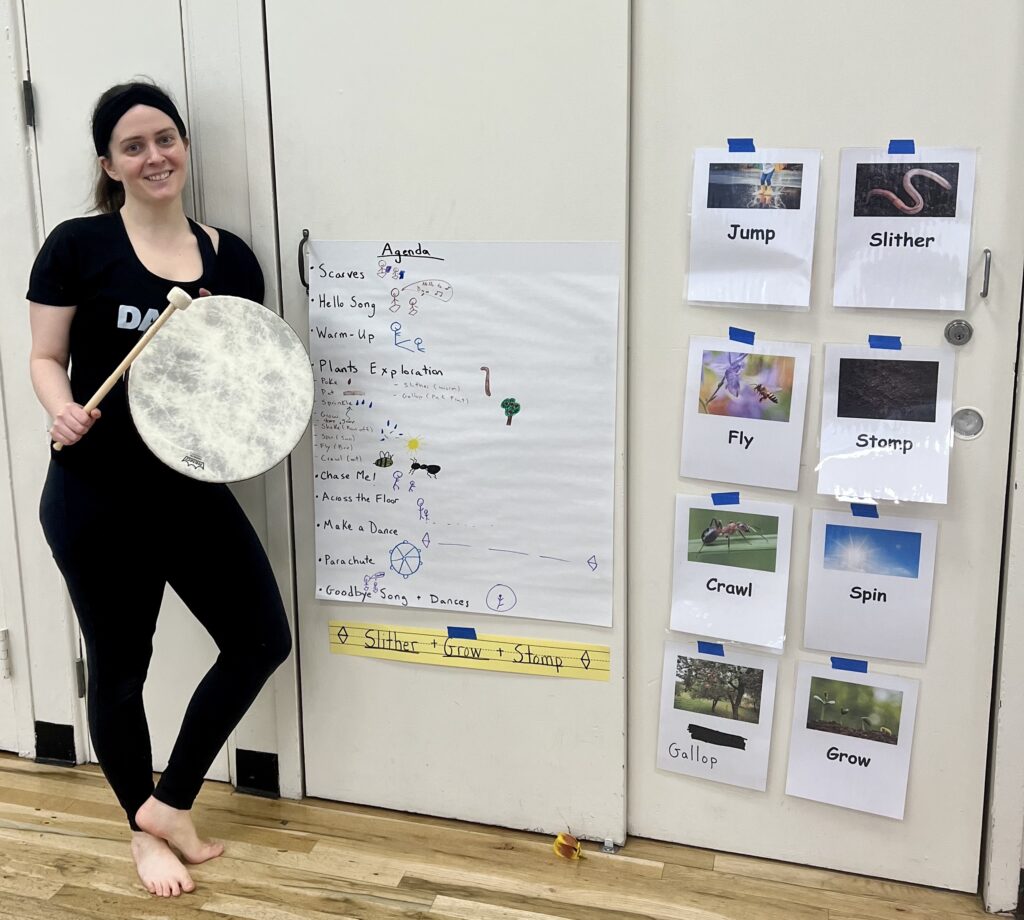
While Daria Fitzgerald was a long-time dance student, she never thought to major in dance during college. She felt “nervous and insecure,” as she puts it, and had the misconception that one needed to fit a specific body type. Instead, she pursued a completely different route, earning her undergraduate degree in theology from Sacred Heart University in Connecticut.
She continued taking dance lessons through adulthood, when her teachers from a choreography class began telling her about dance in preK-through-12th-grade schools. “I didn’t know much about what dance could be besides studio classes like ballet, tap, jazz, and hip hop, so they encouraged me to investigate it more,” she says.
That led her to eventually pursue her postgraduate studies at New York University. In 2018, Fitzgerald received her master’s in dance education from NYU’s Steinhardt School of Culture, Education, and Human Development and her New York State dance teacher certification.
In 2021, she began teaching children’s classes at The 92nd Street Y, New York. She currently teaches dance through 92NY’s Nursery School, Parenting Center, and Harkness Dance Center. As a 92NY Dance Education Laboratory (DEL) Facilitator, Fitzgerald has presented in several DEL courses, such as DEL Early Childhood; DEL Dances from Uganda, where she presented her research on how children’s games can be used to teach dance technique and choreographic tools; and DEL Hip Hop for Social Justice, where she presented a hip-hop curriculum that she wrote for The Yard in collaboration with the Wondertwins, Billy and Bobby McClain. She is now working on several DEL-curriculum writing projects. As a DEL Pre-K Create Coach, she supports New York City 3K and preK teachers in developing the skills and knowledge needed to implement dance education practices into their curriculum.

Fitzgerald spoke with Dance Teacher about her challenges and advice for working in early childhood, her biggest role model, and her love for integrating books into dance classes.
What do you love most about teaching at 92NY?
My favorite thing about working at 92NY is collaborating with other teachers. I teach a family dance class for 2- to 3-year-olds and their caregivers with Erin Lally, who is the director of 92NY DEL. I really enjoy co-planning lessons and demonstrating the relationship aspect of the class with Erin so that the children and their caregivers are encouraged to dance together. I collaborate also with the classroom teachers in the nursery school and parenting center. I ask them about what they are studying in class, what the kids are interested in, what kinds of books they are reading, and then I create dance lessons around those themes.
What is the biggest challenge for you working in early childhood and how do you navigate that?
The children come to dance very naturally because my classes are really child-led and exploratory. The biggest challenge is educating the adults. Like in the family dance class, parents and caregivers think they will sit and watch the child dance. So it’s about encouraging them to participate, even if they are slower, can’t get on the ground, or need to modify the movements. When I go into classrooms across New York City, I think some people expect that I want the children to be in lines and they need to copy exactly what I’m doing, but that’s not the case at all. I educate them that there are many different ways for a child to engage, and even if the child is just watching, that is another way for them to learn.
What’s the best and worst advice you’ve received?
Jody Gottfried Arnhold, the founder of 92NY DEL, always reminds me that “There is no dance without dance education.” So, dance educators are important. Another thing she said is that “Every child is born an artist, but the world tries to knock it out of them.” It’s up to us teachers to nurture the artist in the child, affirm their creativity, and give them tools to expand their skills.
The worst advice I’ve received as a dance teacher is that 4-year-olds need to learn discipline and mimic their teacher in dance class. Dance does teach emotional regulation and it is important to have structure and rituals in the class, but it’s not important that they are mimicking me or sitting and being quiet for long periods of time.
What is one unique thing that you like to incorporate into your classes?
I love transforming pictures and words from books into a multisensory dancing experience in creative movement and ballet classes. I use books to teach the storytelling aspect of ballet, introduce dance history, and reinforce vocabulary. Books are also powerful in combating stereotypes, so I like to choose stories that have positive messages and diverse characters. I have a book Instagram page called @booksfordancing to share books that I use in my classes and recommendations by other authors and dance teachers.

Do you have a favorite book?
One book that I really enjoy is I Am Enough, by Grace Byers. It’s a book of positive affirmations. It is short and simple enough that you can do it with a preschool class and has good illustrations and action words that translate well into movement. I also read it to second-graders. I had them write their own inspiring sentence, which they then used to choreograph something.
Have you had a role model in dance education?
Deborah Damast was my professor at NYU and is the director of the NYU Dance Education Program. She is a tireless advocate for dance education and her students. Something I am so grateful to her for is that she connects her students and alumni with opportunities that are the right fit for them. She knows early childhood is my thing, so if someone needs something [for that group], she will connect me. She has a wonderful career, but she doesn’t stop there. She helps other people build their careers.
Do you have any advice for dance educators on how they can best work with early childhood students, their parents, and teachers?
The first thing I would suggest is to observe as many classes as you can—both studio classes and classroom teachers. I taught for a few years at a public preK center in the Bronx, and I learned so much from the teachers there about how to resolve conflicts with young children and how to speak with kids.
You also need to learn patience. You have to accept that you cannot force a 4-year-old to do anything. Plan meticulously, but go with the flow and be ready to change your plan in the moment.
Learn as much as you can from parents and teachers about their child and students. Young children are capable of so much. Don’t underestimate them.





